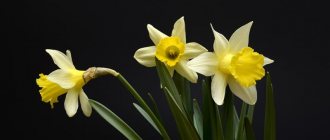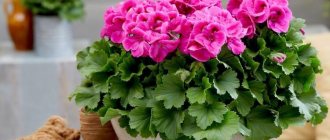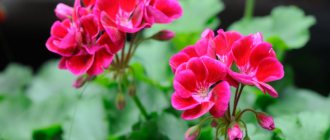Over two hundred years of growing as indoor plants, geraniums have firmly entered the everyday life of Russians. Pink, scarlet, white and variegated umbrella inflorescences of pelargoniums or geraniums can be seen on the windows of city apartments, in summer cottages on summer days and on the verandas of rural houses. The flower, which has become truly popular, actually comes from South Africa, for which Russian conditions are not always comfortable.
In nature, wild geraniums are perennial plants:
- with powerful, weakly branching shoots;
- with smooth or slightly pubescent split leaves;
- with umbrella inflorescences containing up to 20 individual flowers.
The culture is valued for its mass production and duration of flowering, which, with proper care of geraniums at home, lasts from spring until pre-winter. At the same time, many species are quite fragrant, and the plant’s docile nature is its great advantage.
When kept at home, decorative varieties of geranium remain decorative for at least 4–5 years. But properly organized care helps extend the life of a flowering specimen to ten years or more. How to care for geraniums so that they bloom and remain attractive and healthy for a long time?
Origin of geranium
Geranium came to European windowsills in the 17th century, being brought to England by sailors from southern countries - Africa and India. In its historical homeland, this plant is a perennial and wild-growing plant; it is a subshrub with powerful shoots, smooth, slightly pubescent leaves and umbrella-shaped inflorescences. In the natural environment, geranium can also be found in Madagascar, Australia, New Zealand and California.
A beautiful and bright flower has another name: “crane bird”
Information: the geranium family has many faces, numbering up to 800 species. The name is of Greek origin. Geranios is translated as “crane” - due to the similarity of the plant’s fruits to the beak of this bird.
Geranium became a decoration for balconies thanks to the efforts of English breeders. Since the 17th century, they have worked tirelessly to develop new varieties and varieties of pelargonium, obtaining double and intricately shaped flowers of various shades, achieving stunning decorativeness and compactness from the plant.
At first, geranium was the privilege of the nobility. It could only be seen on the windows of nobles and on the hats of rich ladies. But as its popularity grew, the flower expanded the boundaries of its habitat, and ordinary people gradually began to breed it.
How to plant correctly?
Choosing a location and lighting
This pelargonium requires a lot of light. With its deficiency, the foliage begins to turn yellow and, over time, completely fall off. Therefore, the most suitable place for a flower is the southern and eastern sides of the room. In winter, you will have to resort to additional lighting.
Important! Make sure that artificial lighting lamps do not leave burns on the surface of terry pelargonium.
Soil requirements
To grow a healthy and profusely flowering plant, you must adhere to the following rules when preparing the soil:
- The substrate must be fertile and loose.
- You can use universal soil purchased at the store, but add peat and coarse river sand.
- Before planting, add mineral fertilizers to the substrate.
- Be sure to put a drainage layer, which can be made from expanded clay pebbles.
- Soil acidity should be at a neutral level.
Description of appearance, is it difficult to keep the flower indoors?
Geranium has a branched root system and dissected or lobed leaves. Their color depends on the type of plant and varies from dark green to grayish and reddish, sometimes with spectacular spots. Geranium flowers are predominantly large in size and can be red, white, violet, purple, orange, or variegated. Collected in racemose inflorescences, 1–3 on a peduncle or can be solitary.
The plant has healing properties; it treats diseases of all groups of organs.
Homemade geranium is not capricious and does not require care. Even a novice gardener can grow a beautiful plant and get it to bloom lushly. It is only important to follow a few basic rules of maintenance, remembering that the homeland of geraniums is warm countries.
- Geranium loves warmth, but not the scorching sun.
- It reacts equally poorly to drying out of the soil and to excessive watering.
- Sensitive to lack of sunlight. Loves southern window sills.
- Needs normal air humidity in the room - without extremes and away from hot heating radiators.
Description and photos of varieties
Purple
This variety includes many more subspecies . For example:
- Brookside Fantasy (light violet-lilac color, rather lush, terry brushes);
- Amethyst (lilac color);
- Lara Gem (lilac shade);
- Bold Pixie (colors vary from lilac to purple);
- PAC Icecrystal (violet-lilac).
White
This type, in turn, is also divided into groups:
- Granny Barter (in appearance they are somewhat reminiscent of the students’ snow-white bows);
- Artic Princess (pure white buds, similar to a ball);
- Delta Pearl;
- PAC Blanca;
- Dowepoint;
- Destiny.
Angel
This variety deserves special attention. In appearance it resembles royal pelargonium. The only difference is in the shape of the bush - in Angel it curls, and does not grow as a lush bush.
Another distinctive feature is the small size of the flowers - usually their diameter does not exceed two centimeters. The height of the bush reaches 35 centimeters. If it goes higher, it should be cut off, otherwise all the decorativeness will disappear. The shade of the petal can be different - from soft pink to lilac. In some cases, there are species with spots and stripes on the inside of the petal.
Types and varieties
Breeders have succeeded in transforming geraniums. Some of its varieties resemble the “source” only remotely. But in all the variety of shapes and colors, experts distinguish 6 main types.
Zonal
They are the most common. The name was given because of the colored halo on the leaves in the form of a ring-zone in the center.
The zonal species is represented by a large number of species and varieties. All zonal geraniums are divided into non-double, semi-double and double - according to the number of petals in the flower. The most lush, terry ones have more than 8 petals, non-double ones are limited to five.
The most common type of plant, includes 17 species
Also in the group of zonal pelargoniums there is a division into subgroups.
- Rosaceae - with flowers resembling roses.
- Tulip-shaped - similar to an unopened tulip bud.
- Carnation flowers - with carved petals of large flowers reminiscent of garden carnations.
- Star-shaped - with sharply shaped flowers and leaves resembling the edges of a star.
- Cactiformes are a rare subgroup of geraniums with elongated flower petals rolled into a tube.
- “Deacons” are geraniums characterized by their compact shape and abundant flowering. Flowers in pink, orange and red shades.
Fragrant
Depending on the type, scented geranium can exude 26 different scents
A group of geranium varieties bred for their scent. Outwardly, this species is unprepossessing - the flowers are small, inconspicuous, the bush is lanky, the leaves are inexpressive. But! Very fragrant, striking with a range of aromas - apple, pineapple, peach, grapefruit, wormwood, mint, rose, pine needles, verbena, oriental spices and herbs...
Ivy-leaved or ampelous
This species is bred to decorate balconies and loggias. Hanging shoots of ampelous pelargoniums look great in hanging flowerpots.
This type of plant is often used for hanging decoration of summer cottages and houses.
The second name - ivy-leaved - geranium received for its hard and dense leaves, as smooth as those of ivy.
Royal
The most striking and memorable subspecies of the plant
It lives up to its name with a powerful bush and large flowers - up to 7 cm in diameter. Of all the decorative species, this one is the most capricious to care for and has the shortest flowering period.
Uniques
One of the oldest types of geraniums, bred in the mid-18th century by crossing royal and brilliant pelargoniums. The presence of “royal blood” makes their flowers similar, only smaller in size.
Difficult to care for, but delightful-looking flower
Unicums are popular among garden gardeners. To bloom, this species needs to grow to 50 cm. Also, unique plants need pruning and pinching, so they bush themselves reluctantly.
Angels
They are often confused with royal geraniums, but this is wrong. “Angels” is a separate species, bred through crossing curly and royal pelargoniums and then undergoing a process of hybridization within its group.
A masterpiece of selection, “inherited” from its parents aroma, aesthetic appearance, growth rate
The flowers and leaves of the “angels” are smaller than the royal ones. The bushes do not grow vertically, but in an ampelous manner and are not as capricious in care as their royal relatives - they are more resistant to temperature changes, tolerate dry conditions better and grow faster.
Try other geranium varieties from a reputable supplier:











